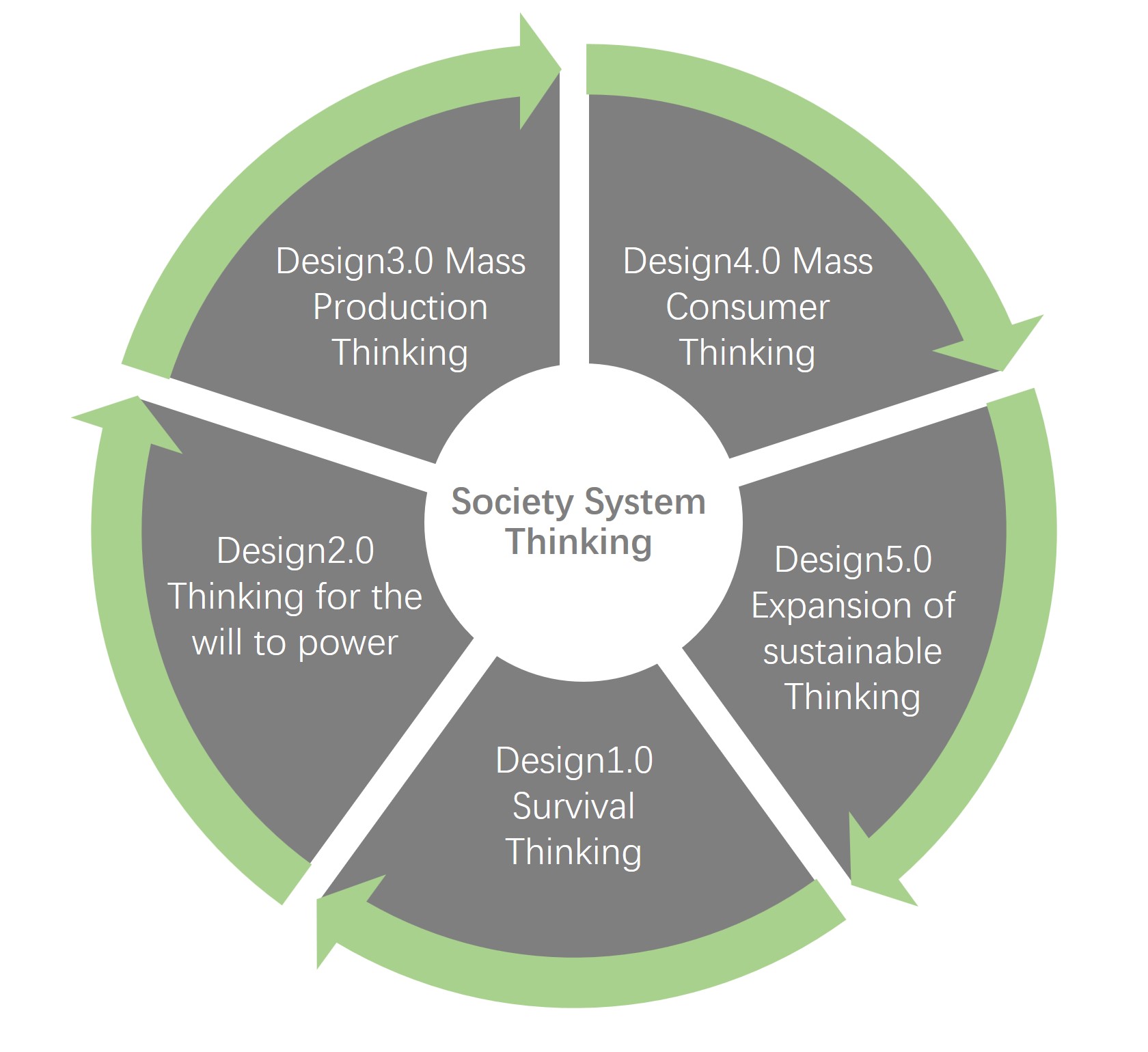Design 1.0 to Design 4.0 represents a shift from “object-centered” to “human-centered” innovation, but retains the paradigm of designing at the expense of the environment. Each successive technological and social change has had a significant impact on the ecology of design and society, as well as on the way humans produce and live their daily lives. Each time, a new face emerges. The face of the twentieth century, for example, was transformed not only by the engineering revolution that replaced the horse-drawn carriage with the automobile, but also by a series of changes triggered by innovations in modes of production the Ford assembly line introduced. Whether it was the artistic design of the first half of the twentieth century in Europe, which concerned aesthetics, or commercial design in the United States, which entailed constantly changing styles, technology drove the focus of design. At present, the mobile internet and ever-changing algorithms are changing the face of the twenty-first century. As a result of this historic shift, design has evolved from a tool of survival, power, marketing, and service to one that facilitates humanity’s search for never-ending opportunities in outer space.
From Design Thinking to Social Thinking: Cognitive Capacity and the Power of Human Innovation
Design has played an important role human social innovation. We have used design to change the face of our environment and to shape our own image. Design thinking differs from traditional artisanal thinking in that it extends beyond the artisanal focus on the perception of objects and to a new level of awareness in industrial societies and their publics. Design thinking plays an active role in analyzing human problems and developing solutions to them. However, designers use design thinking differently from how engineers seek solutions to problems. Design thinking helps designers address the relationships between people and objects and between people and society. By contrast, engineers use technical thinking to address the mechanical effectiveness of equipment, which thus concerns the relationship between technology and equipment.
As a methodological tool, design thinking can be disseminated, and even replicated and adapted, in culturally appropriate ways, to prevent the problem of repetition across different contexts and the sub-problems of the “single model.” With the advent of Design 5.0, in a context that combines colossal amounts of information and data, diverse and individual needs, and the need to adapt to new demands solving multimodal problems imposes, design problem-solving has expanded from hardware to software products. For example, the sustainable design principles of “from cradle to cradle” and that of the circular economy do not really achieve the goal of “no waste.” Even community waste separation and recycling programs are only limited efforts. The Earth’s overall system, including human life, is a complex system. Partial use of waste-free products or re-use of waste will not reverse the overall destruction of the environment. Any efforts we make will only have the effect of delaying degradation. They cannot stop the ecological damage at the root—this is the limitation of design thinking.
From the linear design thinking of the traditional artisans’ age to the rigorously derived double masonry model of the industrial age, to the flexible waterfall model of the information age, design thinking has proven its validity and specific value for solving design problems during specific time periods. However, these design-thinking and design methodologies are no longer used as the main tools to solve contemporary design problems. Social thinking is seen as the source of human creative power.
Social thinking is an extension of design thinking, with the relationship between the two not one of substitution, but rather one of inclusion of the former within the latter. In contrast to design thinking, social thinking is no longer limited to the solution of particular problems or relationships between groups or individuals, but instead includes understanding and resolving complex problems as part of social systems. Social thinking takes a macro perspective, instead of a narrow situational one, and reflects systemic thinking. In contradistinction to design thinking, social thinking does not propose a solution to a problem, but instead a balance among various stakeholders such that a problem is not necessarily solved, but a temporary balance of interests achieved as a result of compromise. In this sense, “wicked problems” are not design problems that require truth and solutions, but rather questions of interest in the complex relationships of social systems. In the social existence of everyday life, which is the focus of third wave sociology [5], social thinking is more conducive to dealing with the “wicked problems” that are so deeply embedded in social relations than is design thinking.
Spontaneous Order and the Construction of Rationality: The Contradictory Social Nature of Design
In an industrial age during which traditional ethics are rapidly dissolving, the value of design becomes apparent in the creation of commercial value in the marketplace, rather than in the creation of public good. If Industry 1.0 is the result of the steam revolution, Industry 2.0 the result of the electricity revolution, and Industry 3.0 the result of the electronic revolution, then Industry 4.0 is inevitably the result of a new evolution of production methods driven by the internet. This stage represents neither a national industrial strategy nor a company’s market decision, developed according to human reason. Human and social development ultimately emerge from technology-driven evolution that affects not only who designs services, but also how they are delivered and how they shape society.
Human design has never been a tool for rational construction. Nor has it been a means of expressing emotions. Rather, it is a tool that allows for the constant adaptation of services and service products in response to human factors, events, and technological advances. Rational construction is the result of engineering thinking and only applicable to products or to fields that require technical efficacy. Rational construction oriented towards the needs of everyday human life is doomed to failure, and rational constructs oriented towards human communities will inevitably revert to the principle of spontaneous order. Human life and social behavior cannot be constructed in a rational, quantitative manner. Evolution and spontaneous order are two of the key concepts Friedrich August von Hayek (1899–1992) proposes [6].
In prehistoric societies, clan and tribal settlements emerged from the need to survive. In feudal societies, cities grew out of the exchange of material objects. In industrial societies, cities further developed due to the need for intensive labor. All these social residential formations were the result of spontaneous evolution instead of rational thinking. Artificially constructed cities and their landscapes cannot be self-sustaining, if they defy environmental climatic and geographical conditions, which is what social thinking requires. In contrast, design as part of spontaneous evolution not only does not fundamentally interfere with the external aspects of people’s daily lives, but it also meets real needs and leads to sociality that flows smoothly.
The periods of time covered by the stages of Industry 1.0 to Industry 4.0 do not coincide with those of Design 1.0 to Design 4.0. The industry 1.0 to Industry 4.0 stages instead correspond to Design 3.0 to Design 4.0 and are thus incompatible. To be precise, Industry 1.0 to Industry 4.0 is an incorrect formulation. The reason for this is that it ignores the development of Agriculture 1.0 to Agriculture 4.0 and Service Sector stages 1.0 to 4.0 [7]. In other words, the division of agriculture, industry, and services into three different industrial models at different stages of the evolution of human society not only ignores the fact that agriculture, industrial manufacturing, and services have moved towards digitalization in tandem, but also splinters the connectedness that exists among them. An artificial emphasis on industrial manufacturing’s production model does not truly describe and account for the evolution of production methods and productivity at different stages of human social development. In particular, it ignores the fact that design is not only a product of industrial society.
The social nature of design reveals itself in the objects it focuses upon and the goals it pursues. The contradictory nature of design is that its activities fundamentally promote the development of society and human beings, requiring a constant supply of resources from Earth. Human development is in an antagonistic relationship to the Earth’s finite resources. Contemporary design must thus act as a mediator between the needs of social development and our limited natural resources. It must transform the “human-centered” concept and the existing model that endlessly satisfies consumer needs.
Design attempts to solve the problems of various time periods, which themselves are various, not only in terms of issues, but also in terms of technical conditions. Design solutions have certain destinies and lose their original value when external conditions change. It is the constant adaptation and adaptation of design solutions to the needs of society that imbue design with instrumental value and efficacy.
Conclusion
With rapid changes in technology, people cannot find solace in the seemingly “good-for-you” environment of commodities. Instead, they attempt to relieve the pressure of their rapidly changing external environments through consumption. This causes them to fall into the trap of consuming products that are given various “meanings.” The main task of contemporary design is no longer to target the function and aesthetics of objects, nor to generate emotional experiences and the meanings that design objects have proliferated, but rather to resolve the “wicked problems” that exist in our social environments and ecological systems. In other words, design thinking must elevate itself to a high level of social thinking in order to meet the challenges of the complexity of contemporary society. This is because all “wicked problems” are not essentially professional problems in design or in other fields, but rather social problems with complex, fluid relationships.
Accordingly, we no longer evaluate design based on whether it is good or bad for the market, useful or useless in terms of experience and efficacy, but rather with regard to the effectiveness of the solutions to social problems and the achievement of public well-being it offers.
Towards a New Innovative Era: Design as Subject of Social Science Research
by Min Wang *
School of Design, Jiangnan University, Wuxi, China
* Author to whom correspondence should be addressed.
JDSSI. 2023, 1(1), 1-6; https://doi.org/10.59528/ms.jdssi2023.0327a1
Received: February 9, 2023 | Accepted: February 20, 2023 | Published: March 27, 2023
Introduction
When the Bauhaus was founded on 1st of April 1919, the architect Walter Gropius read the Bauhaus Manifesto, the first sentence of which proposed subsuming all creative arts and activities under the rubric of architecture. Gropius sought to adopt an integrated, innovative approach to build a new society with modern aesthetics. Today, design concepts developed for everyday objects, which focus on the relationship between form and function of consumer goods, as well as those that engage with the aesthetic and emotional experience of objects, no longer address the new frontiers of contemporary design and the “wicked problems” of social innovation. The design concepts and principles established in the twentieth century are no longer relevant to the design issues of the twenty-first century. The increasingly pressing challenges of climate change, environmental pollution, resource sustainability, educational equality, aging populations, and childlessness make it clear that design must turn to the social sciences for innovation.
Design as a Tool for Society: The Anthropocene and its Evolution in Design 5.0
Examining design in the context of social science, the purpose of gives us the means to solve complex social problems, as opposed to the prior “turn to sociology,” which focuses on everyday life. For example, design sociology for social change [1] and the semantic turn move from semantic products to communities of practice, while design to support an information society that reconstructs itself, the “new foundation for design,” focus on communication. interaction, and participation [2]. In The World as Design, Otl Aicher proposes emphasizing design as a way of life instead of design of objects [3]. Despite working a century apart, Gropius and Aicher concur that practices performed by hand can generate ideas that shape society and daily life. Aicher considers design a tool for grasping the world and society, not just a creative activity that shapes objects. The social sciences should focus on design as an object of study. Design has historically been an essential, creative tool in the production of human society and other life. In the nineteenth century, the prevailing view was that design belonged to the arts and humanities and was an activity closely linked to artistic creation. This view is now outdated and lags behind the design needs of society.
The five stages of design (Figure 1) as a creative tool since the beginning of the Anthropocene are as follows:
- In prehistoric societies, Design 1.0 entails exploration for the sake of survival. Constructing dwellings, polishing tools, and painting ornaments all constitute accumulation of experience and acquisition of a limited ability to survive under natural conditions.
- The Design 2.0 of feudal societies is a tool that serves the will to power. During this stage, design is both secular and religious, and includes tomb, church, and palace architecture, as well as interior decoration and household items, all of which serve the material and spiritual needs of those in power, rather than the everyday needs of the masses. A history of design in feudal societies is a history of the ideas of the powerful and the nobility.
- In industrial societies, Design 3.0 marks a stage of market competition in which design serves as a tool to increase mass consumption. Design 3.0 fosters the democratization of design in society, characterized by a standardized batch approach based on assembly-line production. This promotes and realizes the non-differentiation of mass-consumption goods in the marketplace. Design 3.0 not only encourages the elimination of differences in social identity, but also the construction of a utopian society based on industrial products and industrial culture. Towards the end of the twentieth century, in the wake of the energy crises and environmental concerns, industrial societies have lost their technological confidence, moving away from a “human-centered” paradigm and towards discussions of sustainability. These discussions have entailed questioning the beliefs and systems prevalent in industrial societies and shifting towards an inclusive ideal that advocates harmony between humans and their environments.
- Design 4.0 benefits information societies, representing the stage at which design is a tool that serves the mass media. Design no longer caters to basic human survival or material needs, but has developed into a tool for creating “societies of the spectacle [4].” Undifferentiated mass production ceases to characterize this stage. Instead, mobile internet-based video, information dissemination by text, along with data-driven production and consumption, have come to prominence. A main feature of this stage is that, as individuals’ participation in and influence on social platforms increases, they do not become more tolerant and understanding of each other due to the ease of access to information, but instead atomize into different groups with disparate values and interests.
- In the future, space manufacturing will comprise part of Industry 5.0, which will correspond to Design 5.0, a stage during which Earth’s limited resources will no longer restrict industry and the provision of services. Instead, design will extend beyond Earth into outer space, thus outstripping the innovation activities of Design 1.0 to Design 4.0, which were limited to the Earth’s surface. This will mark a new era for design and constitute a major transformation of industrial models. In this new era, human destructive activities will extend from the horizontal surface of the Earth vertically into space. The benefits of Design 5.0 may be, on the one hand, the avoidance of wars between human societies caused by conflicts and confrontations over the Earth’s resources and, on the other, slowing down humans’ predatory exploitation of the Earth’s natural resources.
Abstract
Looking back on the history of design, it will be found that the four landmark industrial revolutions that occurred over roughly the last century have exacerbated natural resource scarcity, severe environmental problems, and conflicts among various interest groups. Design activities have focused on the development needs of individuals and society. Design innovation has been viewed as a way to add value to goods, a driver of economic growth, and even a slogan politicians use. Content from the arts and humanities, such as aesthetic taste, form, and stylistic elements, has influenced consumer goods to excessive extent. Meanwhile, design, a social practice in which everyone can participate, ubiquitously influences how people live their daily lives. Separating design from interpretations of the arts and humanities and integrating design into the social sciences would provide a new, innovative tool to guide organizations and other decision-makers facing confusing, unpredictable, problematic situations to solve increasingly pressing social “wicked problems.” This article proposes a reconceptualization of design activities as part of social science systems, advocating a shift from design thinking to social thinking and innovations that meet the challenges of contemporary social issues.
Author Contributions
The author has written the article alone without committing plagiarism.
Funding
Not applicable.
Conflicts of Interest
The author has no conflicts of interest with respect to the research, authorship, or publication of this article.
References
1. Deborah Lupton, “Towards Design Sociology,” Sociology Compass 12, no. 1 (2018): e12546. [Google Scholar] [CrossRef]
2. Klaus Krippendorff, The Semantic Turn: A New Foundation for Design (Boca Raton, FL: CRC Press, 2005). [Google Scholar] [CrossRef]
3. Otl Aicher, World as Design: Writings of Design (Hoboken, NJ: John Wiley & Sons, 1994). [Google Scholar]
4. Guy Debord, Society of the Spectacle (London: Bread and Circuses Publishing, 2012). [Google Scholar]
5. Piotr Sztompka, “The Focus on Everyday Life: A New Turn in Sociology,” European Review 16, no. 1 (2008): 23–37. [Google Scholar] [CrossRef]
6. Geoffrey M Hodgson, “Hayek, Evolution, and Spontaneous Order,” in Natural Images in Economic Thought: Markets Read in Tooth and Claw, ed. Philip Mirowski (Cambridge: Cambridge University Press, 1994), 408–47. [Google Scholar] [CrossRef]
7. Miguel Angel Rapela, Fostering innovation for agriculture 4.0 (Springer International Publishing, 2019). [Google Scholar]
© 2023 by the authors. Published by Michelangelo-scholar Publishing Ltd.
This article is published under the Creative Commons Attribution-NonCommercial-NoDerivs 4.0 International (CC BY-NC-ND, version 4.0) license (https://creativecommons.org/licenses/by-nc-nd/4.0/), which permits non-commercial use, distribution, and reproduction in any medium, provided the original work is properly cited and not modified in any way.
Share and Cite
Chicago/Turabian Style
Min Wang, "Towards a New Innovative Era: Design as Subject of Social Science Research." JDSSI 1, no.1 (2023): 1-6.
AMA Style
Wang M. Towards a New Innovative Era: Design as Subject of Social Science Research. JDSSI. 2023; 1(1): 1-6.
Table of Contents
- Abstract
- Introduction
- Design as a Tool for Society: The Anthropocene and its Evolution in Design 5.0
- From Design Thinking to Social Thinking: Cognitive Capacity and the Power of Human Innovation
- Spontaneous Order and the Construction of Rationality: The Contradictory Social Nature of Design
- Conclusion
- Author Contributions
- Funding
- Conflicts of Interest
- References




